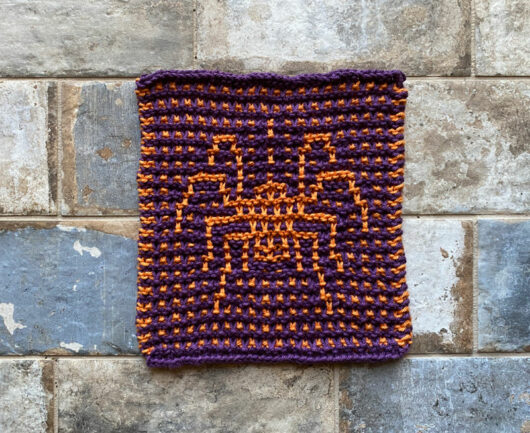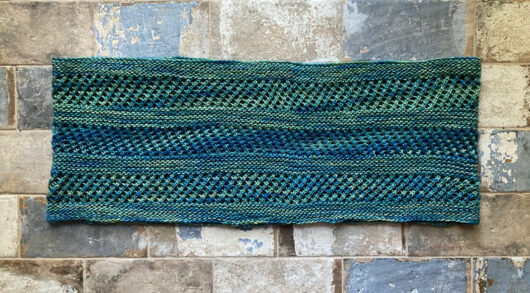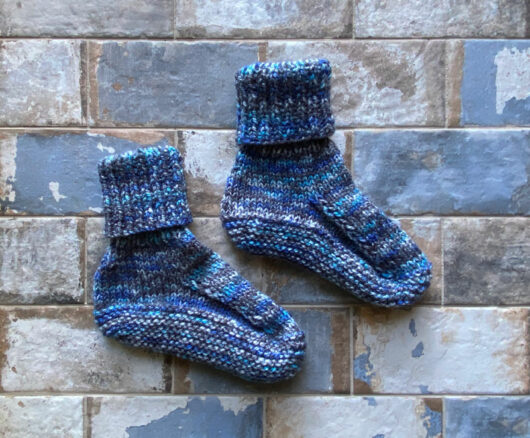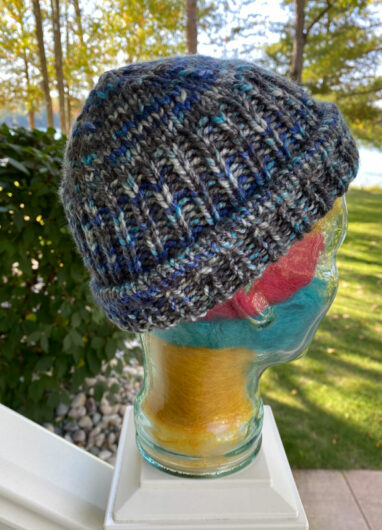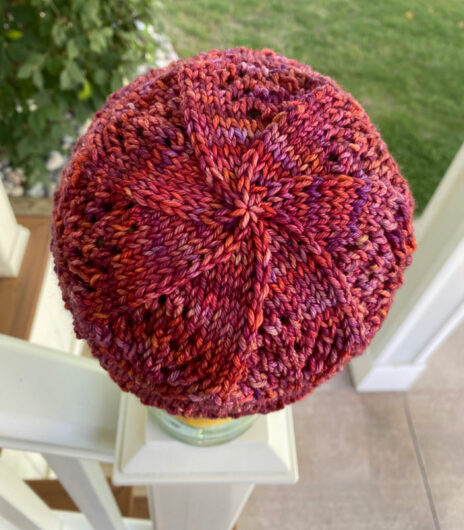
Brace yourself for a hatapalooza. The theme is hats in solid colors. Gloriously pretty and deep clear colors. And even dull and boring colors. But all solids. No speckles. No variegateds.
This first hat is Kathy Zimmerman’s Back Seat Driver Hat, a Ravelry freebie. I knit mine in Sugar Bush Yarn’s Crisp, a DK weight. The colorway is Good Gold. The pattern is an easy, quick knit. The solid color is busy doing what solids often do: showcasing texture.
I have a giant pumpkin head and so do many in my neck of the woods. So I knit the largest size. A 120-stitch cast-on is a very large hat, even in DK. But I love the generous feel of this hat and that the ribbing isn’t stretched while someone wears it.

I’d like this hat more if the crown decreases were a little less fluffy. That can be solved by flipping the ribbing up to pull the hat down at the crown. But I sort of prefer an uncuffed ribbing in this one.
Next up is a classic balaclava: Easy Balaclava by Nanette Blanchard. It’s also a freebie, but you’ll have to step into the Wayback Machine, here, for the pattern.

I knit my helmet in Berroco Ultra Wool. Worked in a solid black there’s no busy yarn to obscure the simple lines of the ribbing.
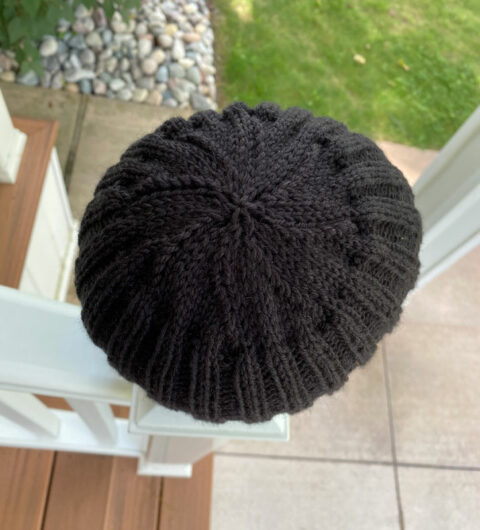
And the crown decreases are nicely well-behaved too.
I made almost no modifications to the pattern. But instead of using a backward loop cast-on above the bind-off (as the pattern directs), I used a cable cast-on. And to strengthen the opening, on both sides where the cast-on met the body of the helmet, I knit 2 together. In the final decrease round, I substituted knit 2 together for the pattern’s knit 3 together. Then I closed the hat with 6 stitches instead of 4.
Next up is Rafa’s Hat, a freebie by Joji Locatelli. She says it’s “a very easy manly hat worked in worsted weight yarn…designed for a friend who (like every man) had very little requirements.”

This time I knit Rafa’s Hat in Berroco’s Ultra Wool in the “Green” colorway. Don’t you love the shade name? Not “Pond Scum in the Moonlight” or “Moss Lurking under a Wet Rock.” Just, “Green.” A no-nonsense yarn for a no-nonsense hat.
My round gauge is always way off when I knit this hat. This time, I knit the largest size but stopped the ribbing in each section at 15 rounds. After 3 repeats, I worked only 4 rounds of ribbing before starting the crown decreases. That worked well. Otherwise the hat would have been too long.

Wouldn’t this hat be cool with that perfect circle of crown decreases knit in a bright yellow?
This next hat is a frequent visitor to the blog: Aimee Alexander’s Boon Island. Not a freebie, but worth every penny. This is the 5th time I’ve knit this pattern and this time I decided to use Plymouth Yarn Worsted Merino Superwash Solid in the “Gold” colorway. Here’s Boon Island as a slouchy.

Here’s the hat cuffed and showing off its underside. If you work this hat with care, in terms of weaving in ends, it’s almost a reversible.

Here’s the tidy crown decreases.

The next pattern and yarn are both new to me: Susan B. Anderson’s Baker’s Hat and Louett’s Gem’s Fingering weight.
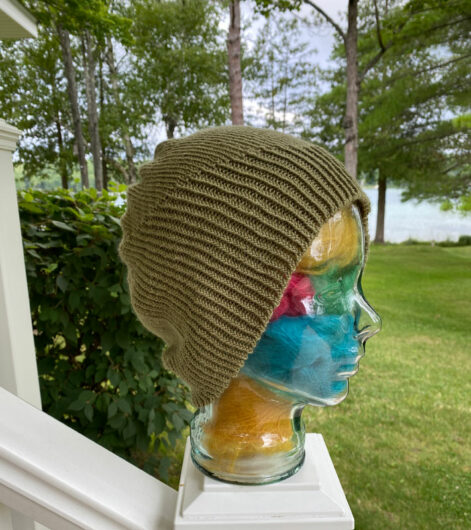
I used a cable cast-on, alternating between knit and purl stitches. It worked out well and made for a very neat edge. My stitch gauge was correct. My row gauge was off. At the end of the twisted-rib stitches, I was already 8 inches from the cast-on (rather than 7.5). I eliminated the extra rounds (5 for my size) and just started decreasing at the end of the twisted-rib rounds. Whether because of the yarn or the pattern, I’m not sure, but I needed to sternly wet-block this hat to tame the ruffle that formed just after the ribbing, as the hat moves into its stockinette section.

The Baker’s Hat crown is a bunch of organized elongated puffy folds. Normally that wouldn’t sit well with me. But for some reason I feel like it works here. Maybe the audacity of how exaggerated they are makes those puffs more acceptable. And, once again, the simple twisted-rib section shows to good advantage in a simple solid yarn.
This last hat is Smith’s Hat, a Ravelry freebie designed by Sanne Kalmbacher. From my first look at the design I imagined Smith’s Hat in a solid, mostly to show off the unusual structure with its twists of ribbing. I knit mine in Plymouth Yarn’s DK Merino Superwash. The colorway is Copper Heather. I see you rolling your eyes already. OK. Heathers are not solids. All I can say is that this “heather” isn’t a heather. It’s a solid. Nice yarn, too.

‘Tis a very strange knit. Which is what drew me to it. It’s given some folks fits to knit. It did for me too but then I found some assistance from other Raveler’s project pages.
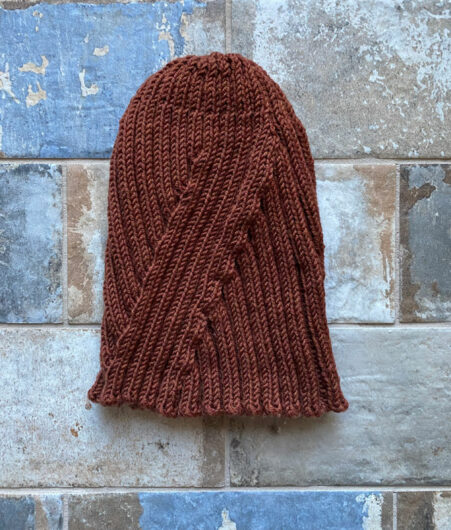
The puzzler is how to get that slanted rib panel to slice its way across the hat.
The M1L and M1LP are worked typically, though the abbreviation key sets out the directions in a way I’ve not seen before.
For the M1L, I picked up the horizontal bar from the front, put it on the left needle point, and knit it through the back loop.
For the M1LP, I picked up the horizontal bar from the front, put it on the left needle point, and purled it through the back loop. Purling through the back is an unpleasant maneuver. Sharp needle points make it easier. Purling through the back closes up a little hole that will otherwise appear in a rather prominent place.
There is a horizontal bar to pick up on every round. Especially at the beginning, it’s a little hard to see. It’s a bit tucked to the nonpublic side, maybe because there’s some pulling going on from all this stitch manipulation.
My fairy godmother on this project is Raveler ESB4. Ethel has line-by-line instructions on her Ravelry Smith’s Hat project page for rounds 6-11 as you leave the twist and form the M1Ls. They work perfectly. Basically, Rounds 6-8 create 3 stitches as you exit the twist, and 3 disappear just before you enter the twist as a result of knit 2 togethers. Same for rounds 9-11. The first trio of rounds creates a set of 3 knits, while the last trio creates a set of 3 purls. As those trios “grow” they become a full 3-stitch vertical rib. I know that if you haven’t already knit this it’s probably not making much sense. But it all works out.

I’m not thrilled with the crown decreases, especially at the start. But that very prominent line of decreases mostly fades into the background once it’s on a head. Felted Head says the hat is quite cozy.
I’ve been doing a good bit of knitting with solids partly because I’ve been gravitating to lots of texture in my knits. Both are good trends. Comforting. Soothing. With nothing to hurt your eyeballs.


